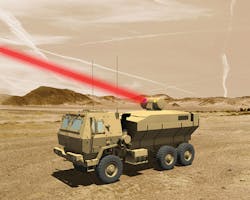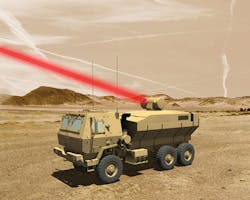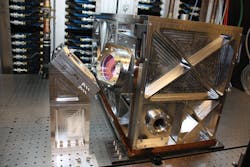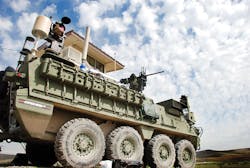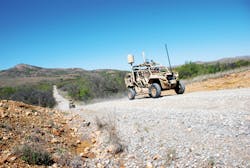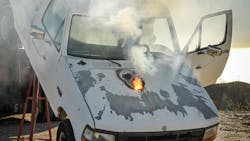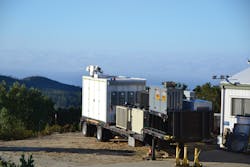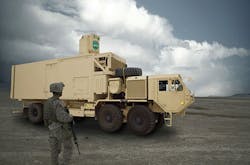At long last, laser weapons are nearing deployment
Once the stuff of science fiction, U.S. military laser weapons now are considered the future successors to missiles and gun systems to protect military forces from enemy boats, unmanned aircraft, ballistic missiles, mortars, and rockets.
BY J.R. Wilson
From the mythical burning mirrors of ancient Greek inventor Archimedes to the Martian death rays of H.G. Wells to Flash Gordon's raygun to Capt. Kirk's phaser, humans have been fascinated by the possible use of light beams as weapons for at least two millennia.
But it was not until the invention of the laser in 1960 that the true potential of that concept led to serious research programs, which led quickly to major size, weight, and power (SWaP) limitations. Laser is short for light amplification by stimulated emission of radiation.
In the decades that followed the construction of the first laser prototype at Hughes Research Laboratories in Malibu, Calif., numerous types of lasers have been developed, based on a variety of power sources and light generation materials, for a wide breadth of applications ranging from barcode scanners to cutting and welding in manufacturing, light shows, DNA sequencing, optical communications, laser printers, and surgery.
One of the first potential laser weapons involved using laser beams as "dazzlers" to blind opponents temporarily. Still, the narrow gap between temporary and permanent blinding led an early ban on that aspect under the Protocol on Blinding Laser Weapons, issued by the United Nations in 1995. Many governments, however, have used loopholes in the Protocol - or simply ignored it - to develop blinding lasers.
The first real laser weapon was the U.S. Air Force/Boeing YAL-1 Airborne Laser (ABL), a megawatt-class chemical oxygen iodine laser (COIL) mounted inside a modified Boeing 747-400F jumbo jet. Designed to shoot down tactical ballistic missiles during their boost phase, it first was test-fired at an airborne target in January 2010 and soon after intercepted three test missiles, destroying two of them.
While technically successful, several limitations led to the ABL's cancellation in 2011. Limitations included the short operational range of the laser beam; the massive size of the system; the aircraft's limited dwell time; the need to refuel the chemicals powering the laser; the number of ABL-equipped aircraft necessary to cover even a portion of the potential threat areas; the number of fighter aircraft needed to protect the ABL; and an overall price tag in the billions of dollars.
While the ABL's chemical laser was "magnificently efficient," its size and pricetag were unacceptable, points out Paul Shattuck, director of directed energy systems at Lockheed Martin Space Systems in Sunnyvale, Calif. "The advent of fiber lasers has allowed us to reduce SWaP to the point where a system can be carried on military platforms on the move - land, air, and sea."
Laser weapons today
Today's enabling technologies for laser weapons are leading to demonstration of 50-to-100-kilowatt lasers that can fit on a majority of existing military platforms, Shattuck says. The 60-kilowatt Robust Electric Laser Initiative (RELI) laser, for example, was designed to go into the Mobile High Energy Laser (HEL) vehicle."
The COIL's size and logistics requirements fell far short of meeting the requirements of the Army, Navy, and Marine Corps, much less the Special Operations Command (SOCOM). Just as that effort was being abandoned, however, new technologies opened possibilities that would meet the demands of the Office of the Secretary of Defense's (OSD's) HEL Joint Technology Office.
"A principal objective of the HEL JTO is to ensure and facilitate the development of HEL technologies to apply across the services and MDA [Missile Defense Agency], then provide avenues to encourage the sharing of information to make sure we are not duplicating efforts across the services or agencies," says Adam Aberle, HEL technology and development demonstration lead at the Army Space & Missile Defense Command's (SMDC) Technical Center in Huntsville, Ala.
The Army's goal is to fit an entire laser weapons system - laser, beam controller, power system. and thermal management - onto today's military trucks, from tactical vehicles, such as the Heavy Expanded Mobility Tactical Truck (HEMTT) to smaller combat vehicles such as the Stryker.
"They must be able to maneuver with the maneuvering force, but we don't want to design a new Army platform to handle a HEL system," Aberle says. "The top-level desire is to have an affordable way to address various threats that endanger the lives of soldiers, such as counter rocket, artillery and mortar (C-RAM) and UAVs. Through the analyses we've done, high-energy lasers provide a means of negating those threats in an affordable way.
"Our primary effort for maturing the state of HEL is the HEL Mobile Test Truck [HELMTT], which ties into the HEL Tactical Vehicle Demonstrator [HEL TVD]," Aberle continues. "The test truck integrates a high-power laser, beam control system, command and control system, power for the laser, and a thermal system to control the heat - all on the HEMTT."
In March 2017, SMDC announced completion of acceptance testing on the Lockheed Martin 60-kilowatt Spectrally Combined High Power Solid State Fiber Laser, which had demonstrated a sustained power of 57.5-kilowatt for a duration of 200 seconds with good beam quality. It was the first successful demonstration of a high-power fiber laser at that power level for defense applications.
Army officials say the tests exceeded the contract threshold for success and, with the addition of three more channels planned before delivery, power will exceed the 60-kilowatt program objective. The laser will be integrated with the HELMTT and used in test environments relevant to warfighting applications.
The rise of solid-state lasers
"Currently, we are using solid-state lasers - specifically combinable fiber lasers that can be ganged together to create a single beam coming out of a beam director. For example, if I had a 1-kilowatt fiber laser and could combine 50 in such a way to create a single defraction-limited beam, I effectively have a 50-kilowatt system," Aberle says. "There are multiple means of combining those and the limits are still being explored.
"There are non-linear effects that limit power scaling of individual fibers and one of our research investments is to develop techniques that can overcome those. We have, in partnership with the HEL JTO, developed a fiber combined laser at the 60-kilowatt class level. That laser has been delivered and we are working on integrating it into the HELMTT and demonstrate it in 2018."
During the Maneuver Fires Integrated Experiment (MFIX) last April at Fort Sill, Okla., an Army specialist with no prior experience with the system became the first soldier to shoot down a UAV - approximately 18-by-10 inches in size - at 600 meters with a laser, the 5-kilowatt Mobile Expeditionary High Energy Laser (MEHEL) mounted on a Stryker armored vehicle. The test was designed to determine how well the average soldier can adapt and effectively use the new technologies.
"One day we want this capability to transition into the hands of the warfighter," Aberle says. "So we gain feedback - 'this worked well, this didn't' - so we can make the technology more useable to a soldier at the end. We don't want to have to create a whole new MOS [military occupational specialty]; it would be additional training they would receive.
"At SMDC, we have done the most development work in how to make the laser very efficient, from the standpoint of power and thermal," Aberle continues. "In the last 10 years, we have gone from systems that were less than 10 percent efficient to our 60-kilowatt, that is greater than 40 percent efficient - that is, transferring electrical energy going into the laser into photon energy coming out of the laser. That advancement has enabled power and thermal systems that are available to fit on platform."
The Navy also has stated it expects laser weapons to become major elements on combat ships.
Laser weapons at sea
"Laser weapons will prove to be a critical factor in future warfare and the Navy is setting the pace for development and procurement of these weapons," says Navy spokeswoman Lt. Kara Yingling. "The specifics of Navy laser needs and requirements are not releasable due to classification. However, they are generally spread across the mission areas of integrated air and missile defense, counter-intelligence, surveillance and reconnaissance and anti-surface warfare. These areas may be enhanced by transformational technology like laser weapons."
The Navy has been testing a new generation of SWaP-improved laser weapons. A 2011 demonstration by the Office of Naval Research (ONR) saw a destroyer-mounted laser defeat several small boat threats. The following year, ONR's Laser Weapon System (LaWS) downed several unmanned aircraft during naval exercises.
"Laser weapons are powerful, affordable and will play a vital role in the future of naval combat operations," retired Navy Rear Adm. Matthew L. Klunder, then chief of naval research, said at the time. "We ran this particular weapon, a prototype, through some extremely tough paces and it locked on and destroyed the targets we designated with near-instantaneous lethality."
ONR describes LaWS as a low-power prototype never intended to be a deployed weapon, but the Naval Sea Systems Command took it when ONR had completed its tests, upgraded it - including linking its targeting system to radar tracks from an MK15 Phalanx Close-In Weapon System - installed the resulting 30-kilowatt, solid-state XN-1 laser on the USS Ponce, deployed in the Persian Gulf, and, following some on-board tests, declared it operational.
"The LaWS was given the task, if needed, to defend the ship. It is probably larger than what the Navy wants in the future, but in terms of putting it on a destroyer, you probably don't need to drive it much smaller. It also has the biggest 'eyes' on the ship and can allow the commander to see things further out than any other sensor on the ship, which is a collateral benefit," says Lockheed Martin's Shattuck.
The Navy's Yingling confirms that sailors on the Ponce used the powerful optics of the LaWS system for intelligence, surveillance, reconnaissance, and combat identification.
"LaWS deployed in 2014 as the U.S. military's first deployed laser weapon system. Still installed on USS Ponce today, LaWS has provided the Navy - and the directed energy community writ large - with lessons that will inform future iterations of laser weapons," Yingling says. "LaWS exceeded all operational requirements and provided valuable lessons in atmospheric propagation of lasers, performance and reliability of a laser system in a maritime environment, integration of laser weapons within existing combat systems architectures, laser safety and airspace deconfliction, tactical employment of lasers, lethality against air and surface targets, and much more."
Navy officials now hope to test a 150-kilowatt-class laser by 2018, with a deployment goal of 2020.
"As the Navy continues to develop laser weapons, there may come a time when they can fully subsume the role currently provided by short- and medium-range interceptor missiles and gun systems. Until such a time as the tactics and capabilities of our laser weapons are proven for the longer term, laser weapons will continue to complement existing weaponry on currently fielded platforms," Yingling adds. "Additionally, laser weapons have the potential to augment maritime domain awareness, improving the overall capabilities of our afloat platforms even when not using them for a high energy laser engagement."
Laser weapons tests
Last April, the Naval Surface Warfare Center Dahlgren Division (NSWCDD) in Dahlgren, Va., announced the transformation of a long-dormant, 100-meter tunnel, crucial to gun range operations during World War II, into a vital new capability for testing laser technologies by the Navy's state-of-the-art Laser Lethality and Development Laboratory.
"A capability such as this allows us to stay in front of HEL weapon lethality testing, modeling, and simulation to support the current and growing number of Navy laser weapon programs," notes Christopher Lloyd, NSWCDD's HEL Lethality lead. "We'll be able to expand the tunnel's range further, up to 300 meters, with some unique test configurations.
"It will soon enable testing in controlled environmental conditions to better replicate weather conditions in regions where deployed HEL systems may operate. We'll be able to study aspects such as beam propagation effects from turbulence and scattering/absorption and how that affects overall system performance."
NSWCDD's commanding officer, Capt. Godfrey Weekes, says adding the tunnel to the LLDL's existing capabilities will enhance innovation and the evaluation of future HELs interoperable with Navy ships and electric weaponry.
"As we continue to develop and deploy laser weapons to the fleet with the inherent advantages of directed energy - speed-of-light delivery, engagement precision, magazine depth, and scalable effects - our warfighters will have a significant technological advantage over our adversaries," Weekes says.
The Navy's program executive office for integrated warfare systems (PEO IWS) is working with industry to develop and field a laser weapon system for installation onboard a late-model Arleigh Burke-class destroyer in the shortest time possible through a full and open competition, says a spokeswoman for Naval Sea Systems Command (NAVSEA). "The Surface Navy Laser Weapon System, Increment 1, will leverage mature technology to deliver a new laser weapon capability to the fleet, which will consist of a HEL, along with a Counter-ISR dazzling capability."
The Air Force has been closely monitoring advances in HEL technology - especially significant improvements in SWaP.
Ready for the battlefield
The most vocal proponent of a new attempt at an airborne laser weapon is Lt. Gen. Bradley Heithold, former head of the U.S. Air Force Special Operations Command (2014-16) and current principal deputy director in the Pentagon's Office of Cost Assessment and Program Evaluation. "I'm a firm believer that it's time we take directed energy in the form of high-energy lasers and move it into the battlefield on an AC-130 gunship," he says. "The next weapon is a directed energy weapon. This is an evolution. It's do-able. The bottom line is, this is a game changer."
His successor at AFSOC, Lt. Gen. Brad Webb, says he hopes to begin testing a laser on an AC-130 within a year, which could set the stage for meeting Heithold's original deadline for deployment in the early 2020s.
In testimony before the U.S.-China Economic and Security Review Commission hearing in February 2017, Richard D. Fisher, Jr., a senior fellow at the International Assessment and Strategy Center, warned of China's rapid advances in laser weapons and how the U.S. must work hard to hold onto its lead.
"For the United States, decades of technology investments in directed energy weapons - lasers, railguns, and high-power microwave - are finally nearing the point of providing next-generation capabilities over potential enemies," Fisher told Congress. "Effective early defensive laser weapons plus defensive-offensive railguns could be deployed in the early 2020s, while multi-platform, high-power but compact laser weapons could be realized in the 2030s. However, it appears increasingly likely that any period of advantage from these weapons could be shorter than expected.
"China's energy weapons program has a breadth and intensity that should greatly concern American and Allied defense planners," Fisher continued. "Some Chinese military experts expect that energy weapons will become more prevalent in 10 to 20 years and will dominate the battlefield in 30 years. As such, it is imperative that the United States redouble its focus to achieve technology breakthroughs needed to realize decisive energy weapon capabilities and be ready to cooperate with critical allies to accelerate co-developments.
"Boeing and Northrop-Grumman are developing a defensive laser pod that by the early 2020s could enable U.S. combat aircraft to disrupt or jam anti-aircraft missile seekers. U.S. officials envision a reduction in laser system size, to 5 kilograms per kilowatt, as enabling tactically sized 300-kilowatt SSLs [solid-state lasers]. By the early 2030s, these may allow 'hard kill' against air or ground targets from F-35B fighters, future tankers or from ship or land platforms."
Directed-energy roadmap
The U.S. Department of Defense (DOD) is drafting a Directed Energy Roadmap to identify those areas where lasers could play a role in the future of warfare. That will include looking at threats, development plans, and concepts of operations, evaluating the current state-of-the-art in laser technology and assessing the advancements necessary to meet service and warfighter needs, Heithold said in an interview with the Institute for Defense & Government Advancement (IDGA) prior to the Spring 2017 Directed Energy & Next-Generation Munitions Conference.
"The study will identify those areas of development that could be consolidated, as well those that need to be expanded. Finally, for the various mission areas, it will identify the technical maturity levels at which transition to the acquisition process is appropriate. The potential to field operational directed energy weapons is exciting and the Department plans to continue to making investments in this area, [although] the overall programmatic organization of the Department's laser development is still TBD," Heithold said.
"Directed energy has the potential of providing DOD with capability advancements in several areas. These include the potential of engaging targets more rapidly than conventional techniques, at greater ranges and with a lower cost per shot. Directed energy offers the potential for silent, precision attack options with reduced signature, and the potential to minimize collateral damage. They also offer the potential of scaling effects from target destruction to disruption, providing warfighters with greater flexibility to adapt to their situation."
Adm. William Moran, vice chief of naval operations, at the 2016 Directed Energy Summit, said the Navy is "fully committed" to lasers and other directed-energy weapons to deal with emerging threats, but added the technology must be pushed forward faster than previous fieldings of new capabilities.
"These technologies are being developed and fielded by a lot of countries. If we don't go forward, we will fall behind," Moran warned. "Low-cost directed energy weapons have to be part of our future. If we have to continue to rely on projectiles, we will run out of the ability to defend ourselves in the future, [so] we are fully committed to taking this into the future."
In testimony before the Senate Appropriations Committee's Subcommittee on Defense on 12 June 2017, Army Chief of Staff Gen. Mark A. Milley noted that rapid advances in technology already are and will continue to change the face of warfare. "For five centuries, armies have depended upon powder propellants to project projectiles through space. Now there is a possibility of alternative means," he told lawmakers. "There are a whole series of technologies out there, all of which are going to impact the character of war. I anticipate within 10 years, maybe 15, a significant increase in the use of lasers, electromagnetic weapons, rail guns, and other things, like robotics and artificial intelligence."
Work to be done
Lockheed Martin's Aberle says much work remains to be done before lasers become truly battle-ready. But even then, and for the foreseeable future, he does not see lasers as being a military "holy grail," completely replacing kinetic weapons.
"There are conditions where you would like to have the ability to make sure the laser beam can propagate appropriately through whatever environmental conditions it faces, with turbulence being a significant one. That is a technology in which we are investing significantly to assess how effective an adaptive optics system can measure that turbulence and what the phase front of the laser looks like. We also are assessing what technologies can be leveraged out of astronomical systems to apply to an HEL," Aberle explains.
"There are certain targets lasers will affect appropriately in the constraints of the battlefield, others that are more challenging. We view laser weapons as complementary to kinetic systems, one where a commander in the field is able to determine which weapon will be most effective in the environment in which they are fighting."
